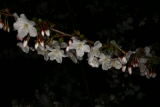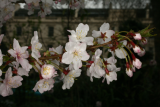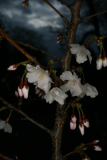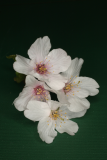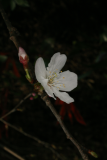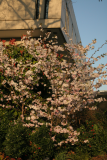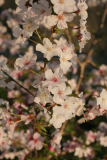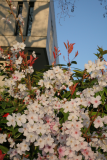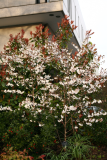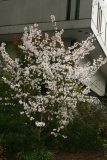Additional notes (click to expand)
Medicinal
In traditional herbal medicine the following notes apply to the species of this tree:
The unripe fruit is antibacterial, antipyretic, antispasmodic, astringent, carminative, cholagogue, pectoral, sialagogue and vermifuge[116, 147, 174, 176, 178, 238]. The fruit has a broad-spectrum antibacterial activity[279]. Cooling and refreshing, it is mixed with other herbs and used internally in the treatment of bronchitis, chronic coughs, chronic diarrhoea and roundworms[174, 238, 279]. The fruit is also used in the treatment of diarrhoea and dysentery, to stop bleeding and to ease coughs[254]. Externally, it is applied to fungal skin infections, corns and warts[238]. The half-ripe smoked fruit is considered to be antispasmodic, carminative and febrifuge[218]. Although no specific mention has been seen for this species, all members of the genus contain amygdalin and prunasin, substances which break down in water to form hydrocyanic acid (cyanide or prussic acid). In small amounts this exceedingly poisonous compound stimulates respiration, improves digestion and gives a sense of well-being[238].
https://pfaf.org https://pfaf.org/user/Plant.aspx?LatinName=Prunus+mume
Toxicity
Prunus ... contain under their bark cyanogenetic glycosides which serve the additional function of deterring rabbits or deer from gnawing them in winter.
Ball, P A J . (1981). Plants, their predators and the physician. Journal of the Royal College of Physicians, London.
The fruit is not toxic. Ingesting the bark could result in cyanide poisoning.
Professor Anthony Dayan, 2022
Geographical distribution
- Asia-Temperate, Eastern Asia, Japan
- Asia-Temperate, Russian Far East, Kuril Is.
- Asia-Temperate, Russian Far East, Sakhalin
Prunus nipponica var. kurilensis 'Brilliant'
Family: ROSACEAEGenus: Prunus
Species: nipponica
Variety: kurilensis
Cultivar: 'Brilliant'
Distribution summary: Russia, Japan
Habit: Shrub
Hardiness: H5 - Hardy; cold winter
Garden status: Currently grown
Garden location: Plants of the World (C)
Reason for growing: Other use, toxic
